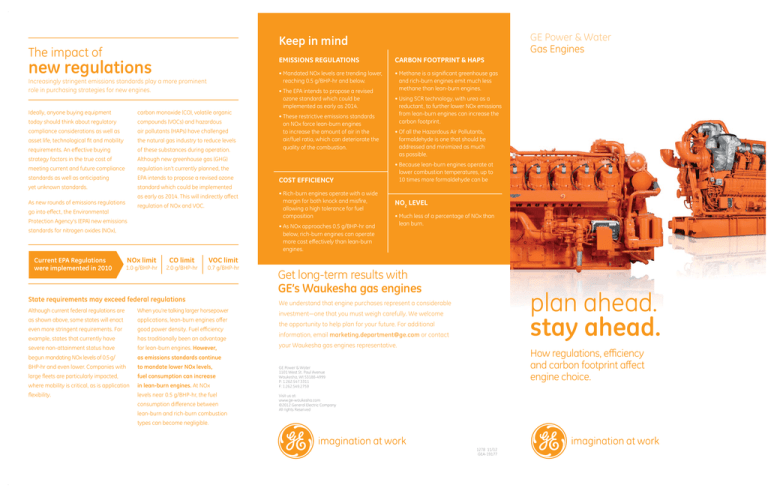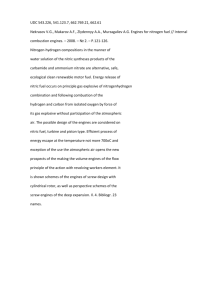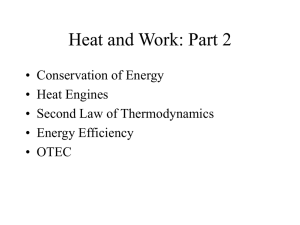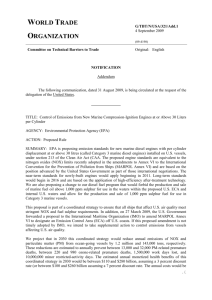
The impact of
new regulations
Increasingly stringent emissions standards play a more prominent
role in purchasing strategies for new engines.
Ideally, anyone buying equipment
carbon monoxide (CO), volatile organic
today should think about regulatory
compounds (VOCs) and hazardous
compliance considerations as well as
air pollutants (HAPs) have challenged
asset life, technological fit and mobility
the natural gas industry to reduce levels
requirements. An effective buying
of these substances during operation.
strategy factors in the true cost of
Although new greenhouse gas (GHG)
meeting current and future compliance
regulation isn’t currently planned, the
standards as well as anticipating
EPA intends to propose a revised ozone
yet unknown standards.
standard which could be implemented
as early as 2014. This will indirectly affect
As new rounds of emissions regulations
regulation of NOx and VOC.
go into effect, the Environmental
Protection Agency’s (EPA) new emissions
EMISSIONS REGULATIONS
CARBON FOOTPRINT & HAPS
• Mandated NOx levels are trending lower,
reaching 0.5 g/BHP-hr and below.
• Methane is a significant greenhouse gas
and rich-burn engines emit much less
methane than lean-burn engines.
• The EPA intends to propose a revised
ozone standard which could be
implemented as early as 2014.
• These restrictive emissions standards
on NOx force lean-burn engines
to increase the amount of air in the
air/fuel ratio, which can deteriorate the
quality of the combustion.
COST EFFICIENCY
• Rich-burn engines operate with a wide
margin for both knock and misfire,
allowing a high tolerance for fuel
composition
• As NOx approaches 0.5 g/BHP-hr and
below, rich-burn engines can operate
more cost effectively than lean-burn
engines.
standards for nitrogen oxides (NOx),
Current EPA Regulations
were implemented in 2010
GE Power & Water
Gas Engines
Keep in mind
NOx limit
1.0 g/BHP-hr
CO limit
2.0 g/BHP-hr
• Using SCR technology, with urea as a
reductant, to further lower NOx emissions
from lean-burn engines can increase the
carbon footprint.
• Of all the Hazardous Air Pollutants,
formaldehyde is one that should be
addressed and minimized as much
as possible.
• Because lean-burn engines operate at
lower combustion temperatures, up to
10 times more formaldehyde can be
NO2 LEVEL
• Much less of a percentage of NOx than
lean burn.
VOC limit
0.7 g/BHP-hr
State requirements may exceed federal regulations
Although current federal regulations are
When you’re talking larger horsepower
as shown above, some states will enact
applications, lean-burn engines offer
even more stringent requirements. For
good power density. Fuel efficiency
example, states that currently have
has traditionally been an advantage
severe non-attainment status have
for lean-burn engines. However,
begun mandating NOx levels of 0.5 g/
as emissions standards continue
BHP-hr and even lower. Companies with
to mandate lower NOx levels,
large fleets are particularly impacted,
fuel consumption can increase
where mobility is critical, as is application
in lean-burn engines. At NOx
flexibility.
levels near 0.5 g/BHP-hr, the fuel
consumption difference between
lean-burn and rich-burn combustion
Get long-term results with
GE’s Waukesha gas engines
plan ahead.
stay ahead.
We understand that engine purchases represent a considerable
investment―one that you must weigh carefully. We welcome
the opportunity to help plan for your future. For additional
information, email marketing.department@ge.com or contact
your Waukesha gas engines representative.
How regulations, efficiency
and carbon footprint affect
engine choice.
GE Power & Water
1101 West St. Paul Avenue
Waukesha, WI 53188-4999
P: 1.262.547.3311
F: 1.262.549.2759
Visit us at:
www.ge-waukesha.com
©2012 General Electric Company
All rights Reserved
types can become negligible.
1278 11/12
GEA-19177
Evaluating rich-burn
and lean-burn engines
GE’s Waukesha* gas engines are designed to perform reliably in isolated,
mission-critical and demanding applications. Featuring durable design and
Achieving
greater
efficiency
Reducing the
In the course of working toward lower
emissions, efficiency can be affected.
More and more, achieving higher efficiency
while reducing emissions is a key objective.
carbon footprint
Measuring the environmental impact of an installation
involves many variables, with some factors playing a
bigger role than others.
Rich-burn engines use a Three-Way Catalyst (TWC), also known as Non-Selective
unsurpassed flexibility, our rich-burn and lean-burn alternatives cover
Catalytic Reduction (NSCR) technology, to lower NOx values. As NOx approaches
While CO2 is the most significant greenhouse
0.5 g/BHP-hr and below, rich-burn engines can operate more cost effectively than
gas addressed globally, methane (also a
a wide variety of applications and varying emissions compliance levels.
lean-burn engines. Below 0.5 g/BHP-hr NOx, lean-burn engines would likely require
greenhouse gas) has 21 times the effect
Selective Catalytic Reduction (SCR) technology. This may result in a net reduction in
on the atmosphere. Rich-burn engines
overall cost efficiency.
emit much less methane than lean-burn
By offering both lean-burn and rich-burn designs, GE’s Waukesha team
engines. Lean-burn engines inherently have
Fuel Efficiency
provides a range of products to help our customers make the smartest
less complete combustion due to lower
Typical NOx vs Efficiency Trade-Off Curve for Lean-Burn Combustion
choice for tomorrow.
combustion temperatures.
BSFC [BTU/BHP-hr]
Advantage Rich-Burn
Helping you plan ahead
The EPA requires that both CO2 and methane
Rich-burn combustion efficiency curve is flatemissions performance is a function of TWC sizing
be included in carbon calculations, and when
methane is factored in, rich-burn engines can
Typical lean-burn NOx-effciency
trade-off curve
deliver lower greenhouse gas emissions.
Attempts to further lower NOx emissions from
There are multiple considerations to take into account when deciding
0
0.5
key considerations, we hope you’ll gain insight and perspective to
make the best decision for your current situation while being mindful
1
1.5
urea as a reductant, can increase the carbon footprint. Looking forward,
both knock and misfire, allowing a high tolerance for fuel composition. At
Factoring in Hazardous Air Pollutants (HAPs)
lower NOx levels, lean-burn engines
Formaldehyde is the most significant of all the hazardous air pollutants
Simplified Combustion Parameters
to site conditions. In addition,
fuel consumption increases and
efficiency decreases as combustion
deteriorates due to the high amount
of excess air used to lower NOx.
combustion temperatures, up to 10 times more formaldehyde can be
Knock Limit
NOx
How combustion and aftertreatment affect emissions
Thermal Efficiency
Rich-burn engines use a lower amount of air in the air/fuel combustion mixture
Stoich
0.8
whereas lean-burn engines put more air into the mixture. For lean-burn engines,
CO, HC
this typically lowers NOx emissions to 0.5 g/BHP-hr. However, other factors worth
Lean
1.0
1.2
1.4
1.6
1.8
Lambda Ratio
Carbon Footprint
Conditions
well suited
for rich-burn
engines:
released than with rich-burn engines.
Misfiring Limit
Rich
Cost Efficiency
emitted by engines. Because lean-burn engines operate at lower
Detonation Region
Engine performance trends as
function of the lambda ratio
and making them more sensitive
* Trademark of General Electric Company
lean-burn engines using SCR technology, with
business decision as an environmental one.
Also worth noting is that rich-burn engines operate with a wide margin for
window, limiting fuel flexibility
Emissions Regulations
2.5
Metha has 21 TIMES the effect
Methane
effect
on the atmosphere as CO2
it’s likely that the carbon footprint size will be considered as much a
operate in an increasingly narrow
of the future.
2
NOx [g/BHP-hr]
which type of engine best suits your needs. By outlining some of these
THREE CRITICAL
CONSIDERATIONS
Greenhouse Gas Issues
• Severe non-attainment areas – 0.5 g/BHP-hr NOx or less
• Looking to reduce NOx, CO and VOC
• Operating over a wide range of fuel quality without knock
• Altitude, mobility and ambient temperature flexibility
2.0
considering include:
• Methane slip due to incomplete combustion resulting in higher GHG
• In general, as an engine is operated leaner, combustion temperature and
exhaust temperature drop steadily, increasing formaldehyde formation.
• Cooler exhaust temperatures make methane slip harder to treat.
• NOx lower than 0.5 g/BHP-hr likely requires SCR for lean-burn engines.
• NO2 is a much lower percentage of NOx..




